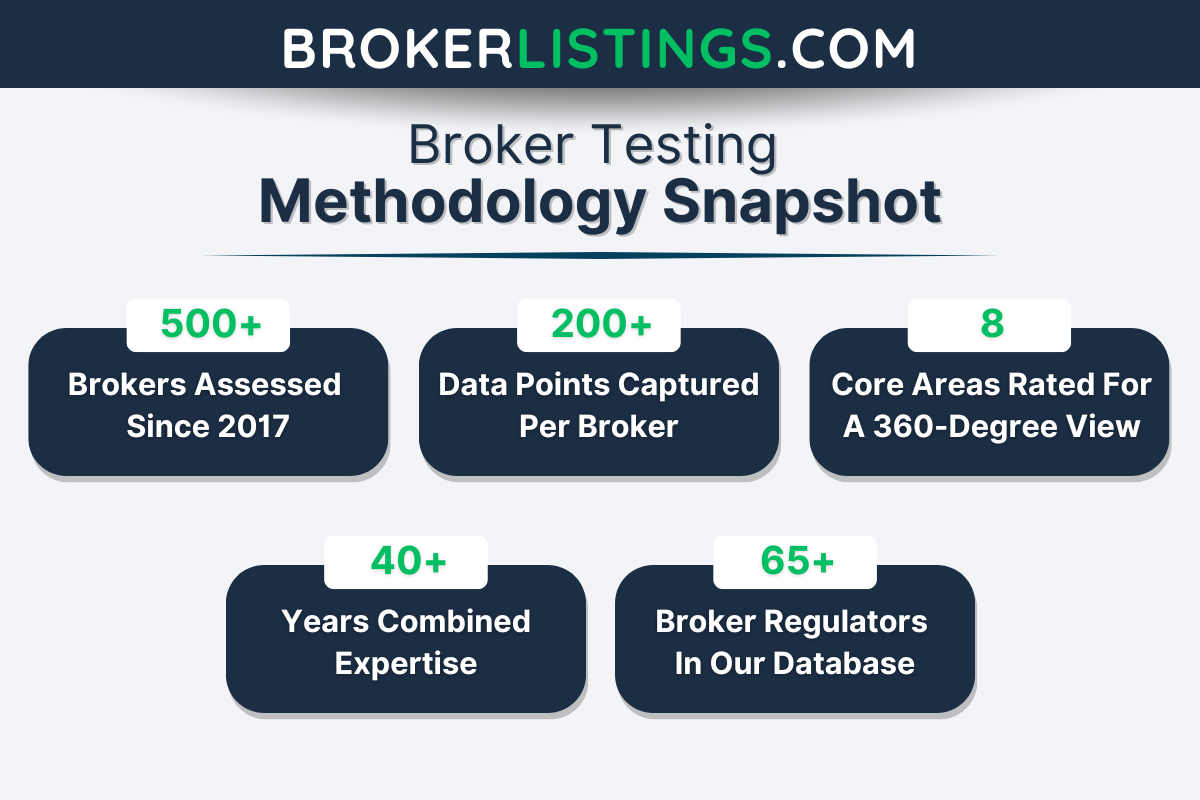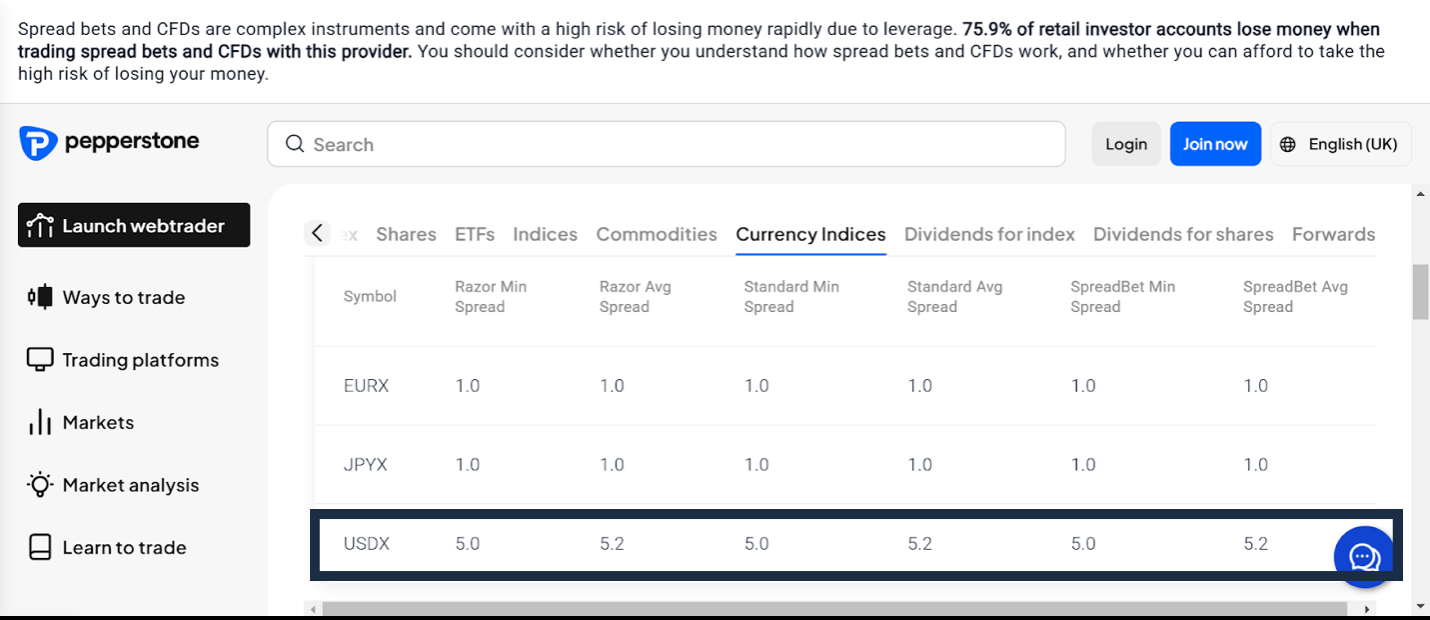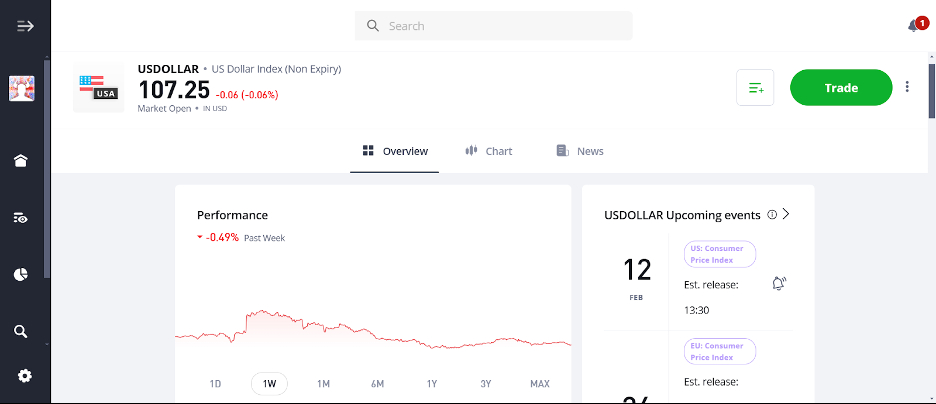Best Brokers With US Dollar Index 2026
Drawing on our hands-on testing experience, explore the best brokers for trading the US Dollar Index, offering diversified exposure and hedging opportunities.
-
1Founded in 2004, Dukascopy Bank SA is a Swiss online bank and brokerage offering trading on over 1,200 instruments, including binary options. It provides various accounts (JForex, MT4/5, Binary Options) and advanced platforms (JForex, MT4/MT5) with strong tools and market data for active traders.
-
2
Trust Platform Assets Fees Accounts Research Education Mobile Support 4.6 Established in 2008, Exness is a respected broker known for offering over 40 account currencies, a wide choice of CFD instruments, and an intuitive web platform with features like currency converters and trading calculators. -
3
Trust Platform Assets Fees Accounts Research Education Mobile Support 4.8 XM is a global forex and CFD broker with over 15 million clients in more than 190 countries. Since 2009, it has offered low trading fees on over 1000 instruments. The broker is well-regulated by authorities such as ASIC, CySEC, DFSA, and SCA in the UAE, and provides a full MetaTrader experience. -
4
Trust Platform Assets Fees Accounts Research Education Mobile Support 4.9 Founded in 2006, AvaTrade is a top forex and CFD broker trusted by over 400,000 traders. Regulated in 9 regions, it handles more than 2 million trades monthly. AvaTrade offers platforms like MT4, MT5, and WebTrader, with over 1,250 instruments. Traders of all levels can explore CFDs, AvaOptions, and AvaFutures for short-term trading. AvaTrade provides excellent education and 24/5 multilingual customer support for a complete trading experience. -
5
Trust Platform Assets Fees Accounts Research Education Mobile Support 4.8 Pepperstone, established in Australia in 2010, is a highly-regarded forex and CFD broker serving more than 400,000 international clients. It provides access to over 1,300 instruments through leading trading platforms such as MT4, MT5, cTrader, and TradingView, while keeping fees relatively low and transparent. The company is regulated by known authorities including FCA, ASIC, and CySEC, offering a safe trading environment for all.
Best US Dollar Index Brokers Comparison
Safety Comparison
Compare how safe the Best Brokers With US Dollar Index 2026 are.
Mobile Trading Comparison
Compare the mobile trading features of the Best Brokers With US Dollar Index 2026.
Comparison for Beginners
Compare how suitable the Best Brokers With US Dollar Index 2026 are for beginners.
Comparison for Advanced Traders
Compare how suitable the Best Brokers With US Dollar Index 2026 are for advanced or professional traders.
Accounts Comparison
Compare the trading accounts offered by Best Brokers With US Dollar Index 2026.
Detailed Rating Comparison
Compare how we rated the Best Brokers With US Dollar Index 2026 in key areas.
Fee and Cost Comparison
Compare the cost of trading with the Best Brokers With US Dollar Index 2026.
Broker Popularity
See how popular the Best Brokers With US Dollar Index 2026 are in terms of number of clients.
| Broker | Popularity |
|---|---|
| XM |
|
| Exness |
|
| Pepperstone |
|
| Dukascopy |
|
| AvaTrade |
|
Why Trade With Dukascopy?
Dukascopy is ideal for binary traders who want the reliability of a well-known brokerage regulated by FINMA in Switzerland, offering more legitimacy than most offshore firms. It is especially suitable for experienced traders interested in automating through chained option contracts.
Pros
- The proprietary JForex platform is advanced, offering tools for algorithmic trading, detailed charting, and access to deep liquidity for traders.
- Dukascopy offers top-notch research, including a professional TV studio in Geneva for financial news, market analysis, and daily expert insights.
- Dukascopy provides tight spreads starting at 0.1 pips, leverage up to 1:200 (based on jurisdiction), and volume-based commissions that benefit high-frequency traders.
Cons
- Dukascopy offers educational resources and 24/7 support, but its complex platforms and tools require extensive testing and can overwhelm new traders.
- JForex offers many features, but its complexity makes it less ideal for beginner traders who might prefer simpler platforms.
- Certain account types, like MT4/MT5 accounts, need a higher minimum deposit of $1,000. This might not be suitable for traders with limited budgets.
Why Trade With Exness?
Exness is an excellent choice for active forex traders aiming to reduce costs after lowering spreads, enhancing execution speeds, and offering trading on over 100 currency pairs with more than 40 account currencies.
Pros
- Execution speeds now average under 25ms, providing ideal conditions for short-term traders.
- Exness Terminal provides an easy experience for beginners with interactive charts, and creating watchlists is simple.
- Competitive spreads for USOIL and BTCUSD in 2024 start from 0 pips, with low commissions from $2 per side.
Cons
- Besides a mediocre blog, educational resources are lacking, especially compared to category leaders like IG, which offer a more comprehensive trading journey for new traders.
- MetaTrader 4 and 5 are supported, but TradingView and cTrader are not available yet, despite increasing demand from traders and their integration with other platforms like Pepperstone.
- Retail trading services are not available in some areas, including the US, UK, and EU, making them less accessible compared to leading brokers like Interactive Brokers.
Why Trade With XM?
With a $5 minimum deposit, advanced charting on MT4 and MT5, a growing range of markets, and a Zero account with spreads from 0.0, XM offers what traders need. They have even won our 'Best MT4/MT5 Broker' award recently.
Pros
- XM’s Zero account is ideal for trading with spreads from 0.0 pips, 99.35% of orders executed in <1 second, without requotes or rejections.
- XM offers reliable customer support tested over the years, providing 24/5 assistance in 25 languages, responses in under 2 minutes, and an expanding Telegram channel.
- XM offers over 1,000 instruments, giving traders various short-term opportunities, including turbo stocks, fractional shares, and thematic indices.
Cons
- XM only uses the MetaTrader platforms for desktop trading, offering no in-house downloadable or web-based solutions with unique features for beginners.
- The XM global entity is generally reliable and well-regulated but is registered with the less robust IFSC regulator. It no longer accepts UK clients, limiting its market reach.
- XM is lagging because it doesn’t offer cTrader and TradingView, which are now preferred over MetaTrader for their better user interface and charting tools.
Why Trade With AvaTrade?
AvaTrade provides traders with essential tools: an intuitive WebTrader, strong AvaProtect risk management, a quick 5-minute sign-up, and reliable support for fast-paced markets.
Pros
- Years later, AvaTrade is still among the few brokers with a custom risk management tool, AvaProtect, which insures losses up to $1M for a fee and is simple to use on the platform.
- AvaTrade introduced AvaFutures for low-margin global market access and expanded in 2025 by adding CME’s Micro Grain Futures. Later that year, they integrated with TradingView.
- AvaTrade's support team did well in tests, responding within 3 minutes and providing local support in major regions like the UK, Europe, and the Middle East.
Cons
- AvaTrade’s WebTrader has improved, but it needs more customization as widgets like market watch and watchlists can't be hidden, moved, or resized.
- The AvaSocial app is satisfactory but could be better. Its design, usability, and navigation between strategy providers and account management need improvement to compete with top platforms like eToro.
- Signing up is easy, but AvaTrade doesn't offer an ECN account like Pepperstone or IC Markets, which provides raw spreads and fast execution that many traders want.
Why Trade With Pepperstone?
Pepperstone is a leading choice for trading with low spreads, quick execution, and advanced charting for experienced traders. New traders benefit from no minimum deposit, a wealth of educational resources, and 24/7 support. Operating under ASIC regulation, Pepperstone is a top option for Australian traders and won DayTrading.com's 'Best Aus Broker' award for 2025.
Pros
- Get top-notch customer support through phone, email, or live chat. Expect responses within <5 minutes based on our trials.
- Pepperstone provides impressive transaction completion speeds, averaging about 30ms. This allows for quick order processing and execution, making it suitable for traders.
- Pepperstone now offers spread betting via TradingView, enabling tax-efficient trading with sophisticated analysis tools.
Cons
- Pepperstone's demo accounts last for 30 days. This might be insufficient for learning the various platforms and testing trading strategies.
- Pepperstone does not support cTrader Copy, a popular feature in the cTrader platform available at alternatives like IC Markets, though it has launched an intuitive copy trading app.
- Despite expanding its market range, crypto options are limited compared to other brokers in this area, and there is no option to invest in actual coins.
Filters
Methodology
To determine the best brokers for trading the US Dollar Index, we analyzed over 200 key metrics for each provider in our extensive broker directory.
After rigorous hands-on testing of each broker’s trading software, we assigned an overall score and ranked them accordingly to help traders find the most reliable and efficient options.

What to Look for in a Broker for Trading the USDX
The USDX is like the VIP of currency trading – it tracks the value of the US dollar against a basket of other major currencies, giving you a snapshot of how the greenback is performing globally.
But before you jump in, you’ll need a reliable broker to make it happen. And let’s be honest: not all brokers give equal treatment or access to the USDX.
Here’s what to consider:
Regulation and Safety: Don’t Skip This Step
First things first – safety. Always choose a broker that’s regulated by a reputable authority, like the SEC (US), FCA (UK), or ASIC (Australia). Regulation ensures the broker follows strict rules to protect your money and keep things transparent.
Year after year IG emerges as our most trustworthy broker. It’s a heavyweight in the trading world and regulated by top-tier authorities like the FCA (UK) and ASIC (Australia), so you know your funds are safe.
Trading Platforms and Tools: The Must-Haves
Next up is the trading platform. It must be user-friendly, reliable, and packed with tools to help you make smart trades. Here’s what to look for:
- Charting Tools: The USDX moves fast, so you’ll need advanced charts to spot trends, patterns, and key levels. Look for platforms that offer candlestick charts, technical indicators (like RSI and MACD), and drawing tools.
- Execution Speed: When the USDX makes a move, you don’t want to miss it. A good broker should offer fast, reliable trade execution with minimal slippage.
- Mobile Trading: Want to trade on the go? Make sure the broker has a great mobile trading app. Whether you’re commuting or chilling at a café, you should be able to monitor and trade the USDX from your phone.
Saxo Bank is a premium broker that caters to serious traders. It offers a wide range of assets, including the USDX and its trading platform is packed with advanced features, including customizable charts and real-time data.
Fees and Spreads: Keeping More Money in Your Pocket
Brokers make money through spreads (the difference between the buy and sell price) and commissions. For USDX trading, look for brokers with tight spreads and low commissions. Even small differences in fees can add up over time, so this is a big deal.
Also, watch out for hidden fees, like withdrawal charges or inactivity fees. A good broker will be upfront about their costs, so you know exactly what you’re paying.
Pepperstone is ideal for USDX traders prioritizing low costs and fast execution. It’s got some of the tightest spreads in the industry with lightning-fast trade execution and no requotes.

Leverage and Margin Requirements: Trade Smarter, Not Harder
Leverage can amplify your gains, but it can also magnify your losses. When trading the USDX, you’ll want a broker that offers flexible leverage options. This lets you control larger positions with a smaller amount of capital.
But here’s the catch: higher leverage means higher risk. Make sure the broker offers risk management tools, like stop-loss orders, to help you stay in control.
And always check the margin requirements – some providers require more margin for volatile instruments like the USDX.
AvaTrade offers leverage of up to 1:10 for the USDX, with clear margin details and easy-to-set trading parameters.
Customer Support: Because Sometimes You Need Help
Even the most experienced traders need help sometimes. Your platform might crash, or you have a question about fees. Whatever the issue, you’ll want a broker with responsive, helpful customer support.
Look for brokerages that offer multiple ways to get in touch – live chat, email, and phone support are all good signs. Bonus points if they have a comprehensive FAQ section or educational resources to help you learn the ropes.
Alongside stellar support, eToro stood out during our hands-on tests as a social trading platform that’s perfect for beginners. You can start trading with a small amount of capital and copy the trades of experienced USDX traders automatically.

Demo Accounts: Practice Before You Go Live
If you’re new to trading the USDX (or trading in general), a demo account is a must. It lets you practice trading with virtual money to get comfortable with the platform and test your strategies without risking real cash.
Look for brokers that offer free, unlimited demo accounts. Fortunately, over 90% of the USDX brokers we’ve tested provide a practice trading account.
Expert take: Choosing the right broker might take a little time, but trust me, it’s worth it. A good broker can make your USDX trading experience smooth, enjoyable, and, most importantly, profitable.
FAQ
What is the US Dollar Index (USDX)?
The US Dollar Index, or USDX for short, is like the ultimate scoreboard for the US dollar. It measures the value of the dollar relative to a basket of six major currencies: the euro (EUR), Japanese yen (JPY), British pound (GBP), Canadian dollar (CAD), Swedish krona (SEK), and Swiss franc (CHF).
Think of it as a way to see how the dollar is performing on the global stage. If the USDX goes up, the dollar is strengthening against these currencies. If it goes down, well, you get the idea.
What Does the USDX Tell Me?
- It’s a Global Economic Barometer: The USDX isn’t just about the dollar and reflects global economic health. When it rises, it often signals confidence in the US economy. When it falls, it might indicate uncertainty or weakness. Traders and investors use the USDX to gauge market sentiment and make informed decisions.
- Diversification Without the Hassle: Trading individual currency pairs (like EUR/USD or USD/JPY) can be time-consuming. The USDX lets you trade the dollar’s overall strength in one go, saving you time and effort.
- Hedging Your Bets: If you’re already trading forex or investing in international markets, the USDX can be a handy tool to hedge against currency risk. For example, if you’re worried about the dollar weakening, trading the USDX can help offset potential losses.
- Volatility = Opportunity: The USDX can be volatile, and for traders, volatility means opportunity. Whether you’re into day trading, swing trading, or long-term investing, the USDX offers chances to capitalize on market movements with the right broker.
What Are The Pros and Cons of Trading the USDX?
Pros:
- Simplified exposure to the USD
- Volatility creates opportunities
- Accessible to all traders
- High liquidity
- Hedging potential
- Diversification
Cons:
- Leverage risks
- Complexity of global factors
- Limited currency exposure
- Broker dependence
- Emotional trading risks
- High spread cost/overnight fees




